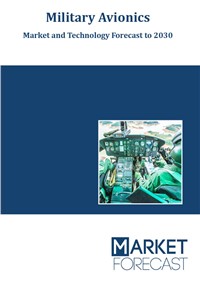The military avionics are electronic systems in military aviation that enable pilots and crews to carry out all types of operations, such as combat, command and control, ISR and SAR, among others. Avionics are the nerve centres of modern-day military aircraft.
Functions ranging from navigation, flight controls and visual aids, to sensor systems and communications are controlled by avionics. These systems have helped the pilots and crews to carry out their operations effectively and also reduce human error involved in decision making. The advancement in functionalities has only been possible due to the continuous innovation in the components involved in avionics. The military avionics market is dominated by companies based in the United States and the EU.
The report “Military Avionics - Market and Technology Forecast to 2030” examines, analyses, and predicts the evolution of military avionics technologies, markets, and outlays (expenditures) over the 2022-2030 period in the defence Industry. It also examines military avionics markets geographically.
Throughout the report we show how military avionics are used today to add real value. To provide the most thorough and realistic forecast, this report also provides a twin-scenario analysis.
Scope
- Overview: Snapshot of the various military avionics sub systems in the defence market during 2022-2030, including highlights of the demand drivers, trends and challenges. It also provides a snapshot of the spending with respect to regions as well as segments. It also sheds light on the emergence of new technologies
- Market Dynamics: Insights into the technological developments in this market and a detailed analysis of the changing preferences of governments around the world. It also analyses changing industry structure trends and the challenges faced by the industry participants.
- Segment Analysis: Insights into the various sub systems market from a segmental perspective and a detailed analysis of factors influencing the market for each segment.
- Regional Review: Insights into modernisation patterns and budgetary allocation for top countries within a region.
- Regional Analysis: Insights into the sub systems market from a regional perspective and a detailed analysis of factors influencing the market for each region.
- Trend Analysis: Key Defence Markets: Analysis of the key markets in each region, providing an analysis of the various sub systems segments expected to be in demand in each region.
- Key Program Analysis: Details of the top programmes in each segment expected to be executed during the forecast period.
- Competitive landscape Analysis: Analysis of competitive landscape of this industry. It provides an overview of key companies, together with insights such as key alliances, strategic initiatives and a brief financial analysis.
Segmentation
The report concentrates on Military Avionics Sub Systems, Platforms, and Integration type.
Sub System
- Navigation
- Communications
- Sensors
- Mission Systems
- Displays & Controls
Platform
- Fixed Wing
- Fighter
- Trainer
- Transport
- Special Purpose
- Rotary Wing
- Light
- Medium/Heavy
- UAV
Integration Type (Fitment)
- Line-fit
- Retrofit
Highlights
- The Military Avionics Industry is projected to register a CAGR of 4.99% over 2022-2030.
- In terms of sub systems, mission systems are anticipated to account for one of the largest shares of expenditure globally.
- The Asia Pacific market is growing rapidly and European vendors can make rapid inroads into this market.
- The fastest growing market from 2023 onwards will be Asia-Pacific as the Australian, Chinese and Indian Government continues to make billions of dollars of investment in this industry.
Reasons to buy
- Determine prospective investment areas based on a detailed trend analysis of the global military avionics industry over the next eight years.
- Gain in-depth understanding about the underlying factors driving demand for different sub systems segments in the top spending countries across the world and identify the opportunities offered by each of them.
- Strengthen your understanding of the market in terms of demand drivers, industry trends, and the latest technological developments, among others.
- Identify the major channels that are driving the global military avionics business, providing a clear picture about future opportunities that can be tapped, resulting in revenue expansion.
- Channelise resources by focusing on the ongoing programs that are being undertaken by the ministries of different countries within the smart weapon market.
- Make correct business decisions based on thorough analysis of the total competitive landscape of the sector with detailed profiles of the top systems providers around the world which include information about their products, alliances, recent contract wins and financial analysis wherever available.




